 Facebook
Facebook
 X
X
 Instagram
Instagram
 TikTok
TikTok
 Youtube
Youtube
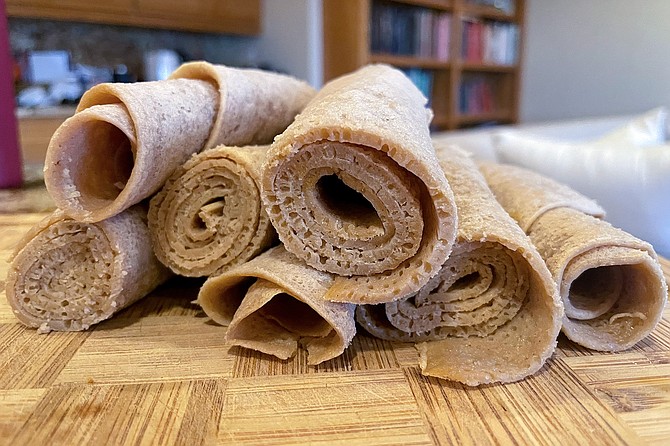
The allure of Ethiopian food, I once wrote, has as much to do with presentation as it does spice. I was but a baby writer at the time, living in Los Angeles, visiting the restaurants of that city’s Little Ethiopia. It would, in fact, be my first published food story.
I picked Ethiopian cuisine specifically due to that presentation, which typically sees a meal of assorted meat and vegetable stews served, family style, atop a large sheet of spongy flatbread. And because it’s eaten, not with utensils, but by hand: you tear off a piece of the bread, and use it to pinch some stew into a little pocket, easy to pop into your mouth. As a newbie, I probably made the trite and true claim that such a bite, “bursts with flavor.”
I do stand by the idea that eating in this manner creates one of the world’s great communal dining experiences. For that reason, it wasn’t long after I moved to San Diego that I found myself at Muzita Abyssinian Bistro, the restaurant that has long brought standout Ethiopian and Eritrean cuisine University Heights. Gather at Muzita, and you may expect plates topped first with injera, that spongey, sourdough flatbread, which is gluten free and made from a tiny North African grain called teff, said to be one of the world’s first domesticated plants.
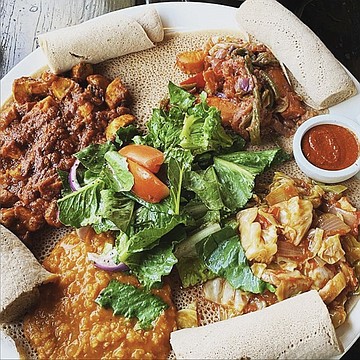
That injera is part of what makes Ethiopian food such a great dine-in experience. Which, naturally, put Muzita at a disadvantage during the early days of covid. A bunch of people, sitting around a table together, grabbing at shared, wet dishes with their hands, didn’t exactly match the national mood in those days. And, traditionally, Ethiopian food hasn’t been a part of America’s take-out menu the way other cuisines have, such as Thai, Chinese, or pizza.
But that’s not to say it couldn’t be.
After the pandemic hit, Muzita adapted. it refined its take-out game and implemented online ordering. Stews, whether meaty or vegan, travel well. So do the dumplings, sambusas. And so does injera, for that matter. The restaurant already offered rolled up slices of it on the side, looking like so many rolled-up hand towels. Easy to put in a box.

The best way to experience Muzita is still in-person. However, the family that founded it seem to have applied their newfound take-out game to a second restaurant: Kemmem. It opened recently in North Park, doing business under the mansard roof of what used to be a Pizza Hut.
Muzita operates within a converted craftsman home, so compared to that warm, wood-grainy interior, Kemmem marks a stark departure. It offers fast casual service from behind wheeled, stainless-steel counters. Steel chairs and stools populate a handful of tables, and window seats face out to the sidewalks and traffic along University Avenue. Rather than wall décor, there are shelves to display sale items including bottled drinks and bags of Ethiopian coffee beans.
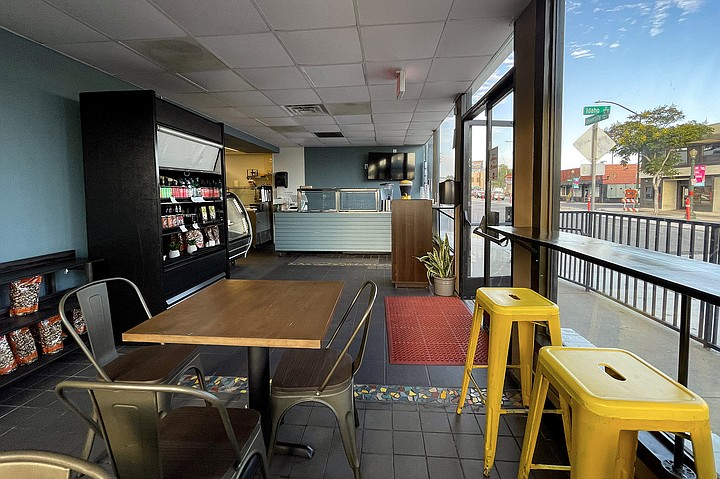
Which is to say, you can always dine in at Kemmem, if it’s convenient. It just doesn’t deliver that aforementioned charm. However, it does deliver, through a few of the usual suspect apps. And it makes Ethiopian take-out a desirable reality in the vicinity of North Park.
The menu’s effectively the same as Muzita, priced a bit lower. For example, the zigni siga, a braised beef with the traditional berbere spice blend (think chilies, cumin, fenugreek) goes for $22 with a side dish at Muzita, or $15 without at Kemmem. A combined dish of shiro + beggie, which puts sauteed cubes of lamb leg over shiro, a sort of ground chickpea curry, cost $26 at Muzita, out the door for $17 at Kemmem.
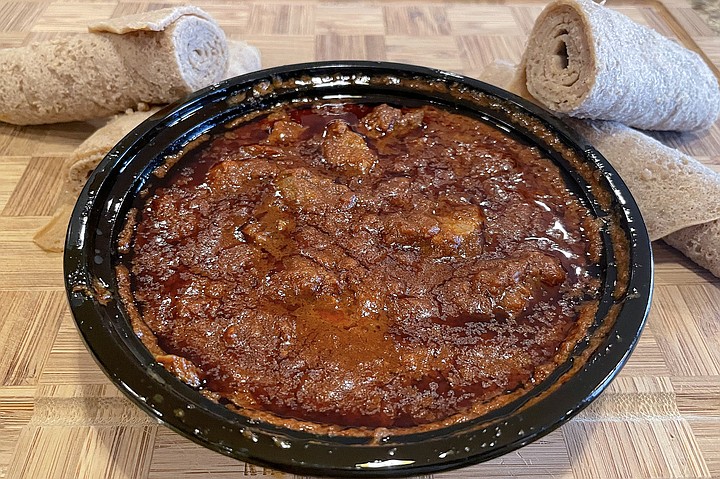
A trio of sambusas mark down from $15 to $12. It’s mix and match, where the dumplings filled with a few of the entrée stews, so I opted for one of each: the cabbage, carrots, onions, and green bean stew called alitcha atakilti; the spinach hamli; and the chicken dish dorho tsebhi, which is also known as doro wat, sometimes called the national dish of Ethiopia. The hamli may have been my favorite, but the addictive, savory dumpling shell is the real star of these sambusas.
Bringing all these dishes home (along with the rolls of injera served with them) did nothing to diminish my enjoyment of the rich, complex spice blends characteristic to this North African cuisine. Actually, with new variants raging, I didn’t mind bringing the food in to eat by hand alongside the members of my pod (if that’s a shutdown-era term people still use). They reheated well, too.
Just like that, there’s a new takeout menu for this food writer who likes to eat with his hands.
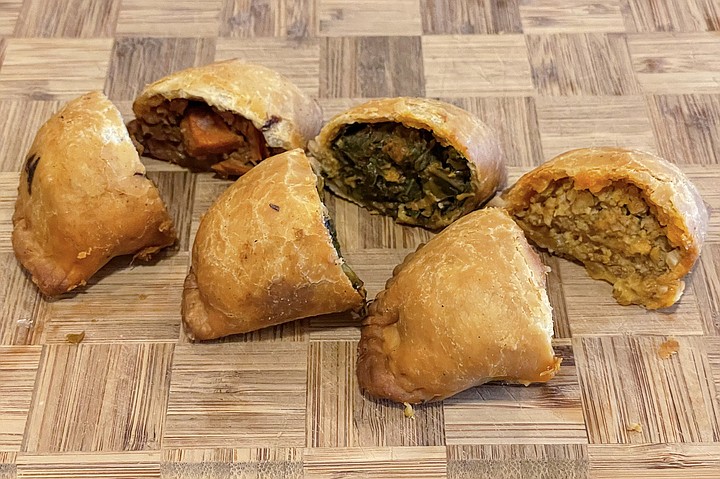


The allure of Ethiopian food, I once wrote, has as much to do with presentation as it does spice. I was but a baby writer at the time, living in Los Angeles, visiting the restaurants of that city’s Little Ethiopia. It would, in fact, be my first published food story.
I picked Ethiopian cuisine specifically due to that presentation, which typically sees a meal of assorted meat and vegetable stews served, family style, atop a large sheet of spongy flatbread. And because it’s eaten, not with utensils, but by hand: you tear off a piece of the bread, and use it to pinch some stew into a little pocket, easy to pop into your mouth. As a newbie, I probably made the trite and true claim that such a bite, “bursts with flavor.”
I do stand by the idea that eating in this manner creates one of the world’s great communal dining experiences. For that reason, it wasn’t long after I moved to San Diego that I found myself at Muzita Abyssinian Bistro, the restaurant that has long brought standout Ethiopian and Eritrean cuisine University Heights. Gather at Muzita, and you may expect plates topped first with injera, that spongey, sourdough flatbread, which is gluten free and made from a tiny North African grain called teff, said to be one of the world’s first domesticated plants.

That injera is part of what makes Ethiopian food such a great dine-in experience. Which, naturally, put Muzita at a disadvantage during the early days of covid. A bunch of people, sitting around a table together, grabbing at shared, wet dishes with their hands, didn’t exactly match the national mood in those days. And, traditionally, Ethiopian food hasn’t been a part of America’s take-out menu the way other cuisines have, such as Thai, Chinese, or pizza.
But that’s not to say it couldn’t be.
After the pandemic hit, Muzita adapted. it refined its take-out game and implemented online ordering. Stews, whether meaty or vegan, travel well. So do the dumplings, sambusas. And so does injera, for that matter. The restaurant already offered rolled up slices of it on the side, looking like so many rolled-up hand towels. Easy to put in a box.

The best way to experience Muzita is still in-person. However, the family that founded it seem to have applied their newfound take-out game to a second restaurant: Kemmem. It opened recently in North Park, doing business under the mansard roof of what used to be a Pizza Hut.
Muzita operates within a converted craftsman home, so compared to that warm, wood-grainy interior, Kemmem marks a stark departure. It offers fast casual service from behind wheeled, stainless-steel counters. Steel chairs and stools populate a handful of tables, and window seats face out to the sidewalks and traffic along University Avenue. Rather than wall décor, there are shelves to display sale items including bottled drinks and bags of Ethiopian coffee beans.

Which is to say, you can always dine in at Kemmem, if it’s convenient. It just doesn’t deliver that aforementioned charm. However, it does deliver, through a few of the usual suspect apps. And it makes Ethiopian take-out a desirable reality in the vicinity of North Park.
The menu’s effectively the same as Muzita, priced a bit lower. For example, the zigni siga, a braised beef with the traditional berbere spice blend (think chilies, cumin, fenugreek) goes for $22 with a side dish at Muzita, or $15 without at Kemmem. A combined dish of shiro + beggie, which puts sauteed cubes of lamb leg over shiro, a sort of ground chickpea curry, cost $26 at Muzita, out the door for $17 at Kemmem.

A trio of sambusas mark down from $15 to $12. It’s mix and match, where the dumplings filled with a few of the entrée stews, so I opted for one of each: the cabbage, carrots, onions, and green bean stew called alitcha atakilti; the spinach hamli; and the chicken dish dorho tsebhi, which is also known as doro wat, sometimes called the national dish of Ethiopia. The hamli may have been my favorite, but the addictive, savory dumpling shell is the real star of these sambusas.
Bringing all these dishes home (along with the rolls of injera served with them) did nothing to diminish my enjoyment of the rich, complex spice blends characteristic to this North African cuisine. Actually, with new variants raging, I didn’t mind bringing the food in to eat by hand alongside the members of my pod (if that’s a shutdown-era term people still use). They reheated well, too.
Just like that, there’s a new takeout menu for this food writer who likes to eat with his hands.
